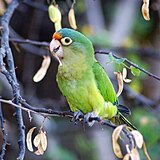
The Gulf of Papagayo (Spanish : Golfo del Papagayo, meaning "gulf of the parrot") is a large body of water off Guanacaste province and the northwestern coast of Costa Rica. The Gulf and its coastline are part of a major tourism project by Costa Rica's government. Among the most popular destinations on the Gulf of Papagayo are Ocotal Beach, Playas del Coco, Playa Hermosa, and Playa Panama. The Papagayo peninsula is the most developed area in the gulf region.[ citation needed ] The gulf waters are home to many wildlife including orcas. [1]
